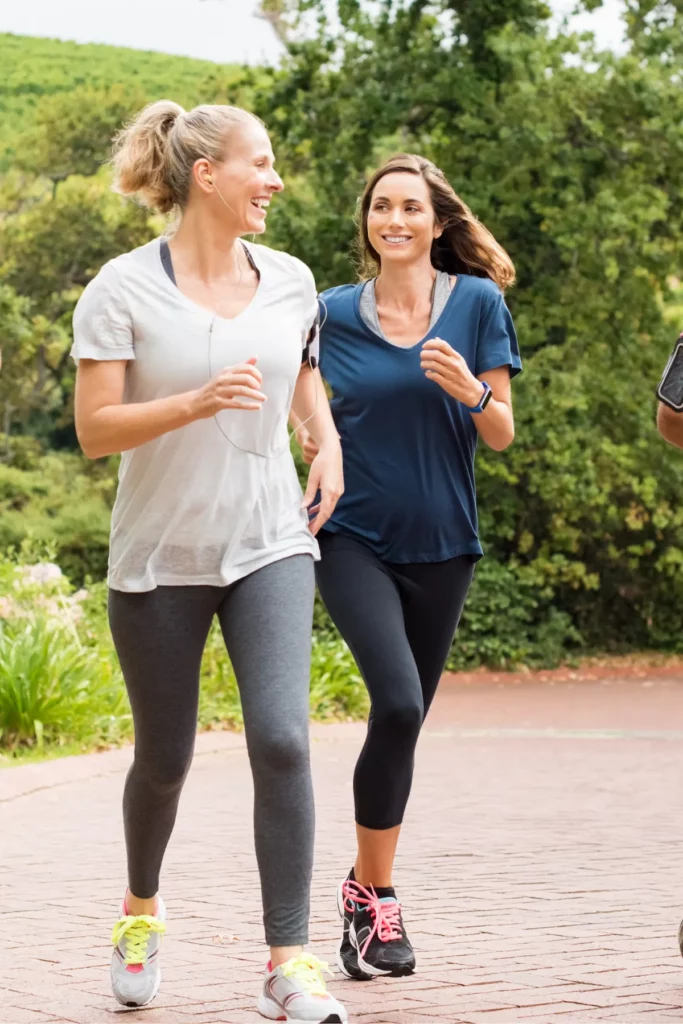As a running and fitness blogger and running coach, I get asked a lot of questions about running.
So I thought I’d put a post together with some of the most common questions I get answered.
I want to share my knowledge not only as a running coach, but as a runner myself.
Running is actually quite a complex sport.
There’s so much more to it than just running.
There are lots to think about, especially if you want to get better at it, from pacing and nutrition and speed to endurance.
Here are 30 of the most common running questions with answers for each.

30 of the most common questions about running answered
#1 Is running good for you?
This is one of the most common questions about running.
Running has many physical and mental benefits and many studies have been conducted over the years to show these.
A 2015 study found that regular runners, compared with people who have never run before, reduced their risk of cardiovascular mortality by 50%.
Running has the potential to improve your heart health, lower your blood pressure and reduce symptoms of anxiety and depression.
Related: Is running good for you? 12 amazing benefits of running for the body and mind
#2 How do I start running?
The best way to start running if you’ve never run before is to follow a plan like Couch to 5k and ease yourself in gradually.
Many new runners make the mistake of thinking they need to run for miles and miles from the very beginning.
They quickly get disheartened when they find themselves out of breath after only a few hundred metres.
You need to build up your endurance, strength and stamina before you can run continuously for miles and miles.
This is why the Couch to 5k plan is so popular because it involves walking intermixed with running for the first few weeks of the programme.
By the end of the programme, assuming you follow it week by week, you should be able to run a 5k (3.1 miles).
Many runners who complete Couch to 5k go on to run 10k races, half marathons and even marathons, so it’s an effective plan to follow and start your running journey.
Related: How to start running when overweight: 12 game-changing tips
#3 What do I need to start running?
One of the best things about running is that you need very little to get started.
Unlike sports like cycling, you don’t need expensive gear.
Here is a checklist of gear to get you started:
- A decent pair of running shoes
- A well-fitting sports bra
- Running leggings or shorts
- Running top or vest
- Running socks
You want to make sure you are wearing gear that is comfortable and supportive.
The last thing you want on a run is to worry about your clothing riding up, chafing or pinching.
Related: How to start running: 39 game-changing running tips for beginners

#4 How often do I need to run?
How often you run will depend on your running goals, fitness levels and lifestyle.
If you’re just starting out, running 2 to 3 times a week is plenty enough.
Whereas if you’re a more experienced runner and training for a marathon, for example, you will likely be running 5 to 6 times a week.
Related: What to expect running 30 minutes a day (and how to start)
#5 Should I run every day?
As I explained above, how often you run will depend on a variety of factors, including your goals, lifestyle and fitness levels.
There’s nothing stopping you running every day, but you’ll first need to assess if this is a realistic goal for you.
There are risks around running every day – namely burnout and overtraining – so it’s about understanding if a daily running habit is for you.
Related: How many miles should I run a day? Benefits + risks of running every day
#6 How many miles do I need to run each week?
The amount of miles you run each week will completely depend on what you’re training for, your running experience and your lifestyle.
Not everyone can get out and go running three or four times a week.
In any case, if you’re unsure as to how much running you should be doing each week, it may be a sign to follow a training plan, especially if you’re training for a race.
The key is to not run too much, or in fact too little, to avoid any nasty surprises in the lead up to race day.
If you’re someone who just loves to run because it feels good, then listen to your body – it will tell you when it’s time to stop or rest.
Listening and tuning into your body takes some practice, but your body (and mind) will thank you for it in the long term.
Related: How long does it take to run a mile? Averages by age and gender

#7 Do I need to warm up before each run?
A warm up is integral to any race – whether you’re running a 5k, 10k or half marathon.
It is important because it prepares your mind and body for the race ahead.
You can think of the warm up as the opening act to your run (the main event). It has three key objectives:
- To prevent injury
- To get your heart rate up
- To get blood flowing to your muscles
A good warm up should leave you energised but not tired.
Aim to include some light jogging, dynamic stretches and running drills.
Related: The 9 best pre-run stretches (and how to do them properly)
#8 Do I need to cool down after each run?
A proper cool down after a run is recommended to help you stay injury and pain free.
When you finish a run, the temptation is to just end it and hop in the shower.
The truth is, skipping a cool down could end up making you feel more uncomfortable later on.
By setting aside a few minutes at the end of your run to stretch out your muscles, you will go a long way to prevent your muscles feeling sore and stiff after a run.
Related: 7 of the best cool down stretches to do after a run
#9 Should I stretch before a run?
Static stretching should only be done during the cool down after a run.
Focus on dynamic stretches before your run as part of a warm up to activate and mobilise muscles like the hamstrings, glutes and calves.
Dynamic stretches are active movements, where joints and muscles go through a full range of motion.
Dynamic stretching is slightly different from static stretching.
It isn’t about holding a stretch but rather taking your body through ranges of motion that will better prepare you for your run.
Here are some good dynamic stretches to do as part of a warm up:
- Forward lunges
- Star jumps
- Side lunges
- Standing knee-to-chest stretch
- Deep lunges
- Leg swings
- Squats
- A-skips
You’ll also want to wake up your glutes and mobilise your hip flexors before a run.
Glute strengthening exercises and hip flexor stretches are great for this.
Related: 5 dynamic hip flexor stretches for runners + how to do them
#9 Do I need to lift weights as a runner?
Strength training, in the form of lifting weights, is one of the best ways to improve your running performance and drastically reduce the risk of injury.
Strength training is essentially a type of exercise that specialises in the use of resistance to build the strength, anaerobic endurance and size of skeletal muscles and bone density.
Essentially it’s a method of training to increase muscular strength, power, size and endurance.
Resistance could be in the form of your own bodyweight or weights such as dumbbells, barbells, kettlebells or medicine balls.
Many runners start with bodyweight exercises like squats and lunges before progressing onto weighted exercises.
The key is to start with simple exercises that you are comfortable doing if you’re new to strength training, then progress from there.
Related: The ultimate 14 day strength training plan for runners

#10 What is speed training?
Speed training (also known as speedwork) is a type of training that is proven to improve your stamina and endurance and help you run faster and more efficiently.
Various studies have shown that speed workouts like interval training, tempo running and Fartlek training allow for similar or greater endurance, strength, and power performance improvements than traditional endurance training.
Here are the key benefits of speed training:
- Demand less time and volume than traditional endurance training (i.e. long runs)
- Easy to fit into your training plan
- Help to build stronger muscles, ligaments and connective tissues
- Help to build speed and power
- Help to prepare your body to run at challenging paces
- Improve running confidence
Related: 7 of the best running workouts to build endurance, strength and speed
#11 What is cross training?
Cross training is all about including a range of exercises and activities in your training plan in order to improve overall athletic performance.
It focuses on your aerobic fitness and has the potential to improve your flexibility, balance, coordination, core strength and endurance.
Your body is a good at adapting to different types of movement and it likes to be tested in different ways.
Cross training is proven to strengthen your muscles and help speed your recovery.
Some good cross training activities for runners include walking, cycling, swimming, yoga and Pilates.
Related: Is CrossFit bad for you? Pros and cons of CrossFit for runners
#12 How can I run faster?
Once you start running, it’s only natural for you to want to run faster and see your times improve week by week.
Despite what you might’ve heard or read, the answer to running faster does not lie in ever increasing mileage.
I know plenty of runners who have upped their weekly mileage in the hope it will make them faster.
When in fact it’s just a one-way road to fatigue and injury.
In order to run faster, you have to think more creatively about your running and train smart.
Running faster is as much about what you do off the running track and is it on it.
Here are my top tips:
- Include more speed training in your training routine. Tempo running, Fartlek, sprint intervals and strides are all good examples of speedwork.
- Run some hills! Hill training is a great way to improve your power and strength as a runner, which in turn makes you a faster runner.
- Strength train. If you want to knock minutes, instead of seconds, off your race time, then I highly recommend incorporating strength training in your training plan. Read my complete guide to strength training for more information.
- Fuel your race. Proper nutrition is key for any runner. Make sure you are fuelling your race in the right way by eating a nutrient-rich diet.
- Rest and recover properly. Don’t be tempted to overtrain. Many overuse injuries like IT band syndrome and runner’s knee are a result of overtraining. Put in place an effective rest and recovery strategy after your long run.
Related: How to run faster and longer: 4 training secrets
#13 What should I eat before a run?
What you eat before a run will depend on a few factors, including your diet, your own eating preferences, and how far you will be running.
The general rule is focus mainly on carbohydrates before a run and protein after a run.
Carbs give you that much needed energy throughout your run, whereas protein optimises the repair of muscles.
A balanced diet consists of the three key macronutrients: carbohydrates, proteins and fats.
But what does this look like on a practical level?
Here are my top tips on what to eat and what not to eat before a run:
- Opt for ‘real’ foods where possible. In other words, try and avoid things like energy bars and gels.
- Avoid foods high in fibre. These are hard to digest and you don’t want your stomach breaking these foods down during your run. High fibrous foods include: legumes, broccoli, apples, pears, cheese, red meat
- Don’t drink too much coffee. Some runners like having a small cup of coffee to get them energised for their run, but avoid large amounts of it.
- Avoid spicy foods. These can cause inflammation in the digestive system.
Here are some good foods to eat before a run and they release energy slowly:
- Banana and almond butter
- Toasted wholewheat bread or bagel with peanut butter
- Porridge with berries
- Plain Greek yoghurt with berries
If you’re planning a short to medium run (so anything below 40 minutes), then aim to eat at least half an hour before your run.
If you’re planning a long run (40 minutes plus), then aim to eat at least two hours before your run.
Related: What to eat before running in the morning: 8 eating tips

#14 What is pacing in running?
Pacing is a runner’s best friend. I’ve relied a lot on it over the years to tell me how I’m doing on a run.
Pacing is basically the number of minutes it takes to run a mile or kilometre.
It’s a critical part of endurance events, like half marathons and marathons, but in my opinion is also very important for shorter races like 5ks and 10ks.
As a runner, it’s important to experiment with a range of different paces during training, especially if you want to run faster and get stronger.
The easiest way to calculate your pace or desired pace is to use a pacing calculator.
There are many versions on the internet nowadays, just type ‘running pace calculator’ into Google. My favourite is the Active pace calculator.
You will be presented with a range of different paces depending on the distance you wish to run and your desired race time.
All I’d say here is that don’t take what the calculator tells you as gospel.
Pacing is dependent upon a lot of things on the day of your run.
Things like how you’re feeling, the weather and the terrain can affect how fast you run on the day.
Related: How to use negative splits to race faster (and happier)
#15 I keep getting injured. How can I stay injury free?
Many runners are forced to hang up their shoes when an injury stops them in their tracks.
And there’s nothing more disheartening (and annoying) for a runner than pain.
Pain can stop you in your tracks or it can be chronic – starting small and gradually getting worse over time.
According to a 2018 study which reviewed over 300 runners over a two year period, 199 (66%) runners sustained at least one injury.
Of those injured runners, 111 sustained injuries more than once.
A good injury prevention strategy is essential for any runner looking to feel good and run strong week in, week out.
The three key elements of this are:
- Listen to your body. Your brain is responsible for sending signals to your body to let it know when to run, when to stop, when to rest, when to recover. Pay attention to your body to avoid common overuse injuries.
- Stretch and foam roll. These are important because they help reduce muscle soreness and loosen any tight muscles after a run and in between runs. When you stretch your muscles, you increase the blood flow into them, therefore increasing the amount of oxygen flowing around your body.
- Strength train. Weak and tight muscles (like your glutes and hip flexors) have been shown to be a cause for various lower body injuries, including hamstring and groin injuries and lower back pain. Incorporate a regular strength training routine.
Related: How to start running again after an injury: 5 tips for success
#16 What are the best running shoes to wear?
There’s no one size fits all approach when it comes to finding the right running shoes.
No human foot is created equal!
There are two key components that determine the type of running shoe for you:
- Your gait (how you run)
- Your footstrike (how your foot lands on the ground when you run).
The amount of miles you’ll be doing each week as well as the terrain on which you will be running are important too.
There are different types of shoes (road running shoes and trail running shoes, for example).
I highly recommend you visit your local running store and get your gait tested.
They will then be able to suggest some shoes based on these results. Most running shops offer free gait analysis.
Related: How to find the right running shoes: A complete guide
#17 What is hill training?
Hill training is a great way to increase your strength and power as a runner, as well as improve your endurance, stamina and VO2 Max.
The fact is, running on a flat surface only gets you so far when it comes to improving strength and power.
Hill training will test your legs, arms and core in so many more ways and will bring a multitude of benefits.
Uphill running also forces you to think about your form a lot more.
You have to use your legs and arms in a certain way to power you up the hill.
In addition, if you struggle with common running injuries, hill running is a great way to strengthen your muscles and connective tissues.
Related: 3 hill sprint workouts to increase strength and power

#18 What is interval training?
Interval training is an excellent way to add intense aerobic and anaerobic exercises into your training routine without having to complete long traditional runs and workouts.
As a form of speed training, interval training used by many in the running community to help them run faster.
It combines periods of short, intense bursts of speed (sprints) with slow recovery periods of mild activity like walking or jogging.
If practiced regularly as part of a structured training plan, interval training can help to improve your speed, strength and endurance as a runner.
Related: What is sprint interval training? Benefits + 3 sample workouts
#19 What is tempo running?
Tempo running is designed to get you used to running at a faster pace over longer sustained efforts.
It involves you running at a sustained effort so you can build up your endurance and stamina over a period of time.
A tempo run should be run at a pace that is about 25 to 30 seconds slower than your 5k race pace.
For example, if your 5k race pace is 7:00 minutes per mile, then your tempo run pace will be 7:30 minutes per mile.
Your tempo run is should feel challenging and comfortably hard, but not so challenging that you’re full out sprinting.
Like other forms of speed training, tempo running is key to being able to run faster.
Related: What is a tempo run? 5 tempo run workouts to improve endurance and speed
#20 What is Fartlek training?
‘Fartlek’ is a Swedish term for ‘speed play’ and is essentially a blend of distance running and interval training.
It was developed by the Swedish Olympic athlete Gösta Holmér as a way to experiment with different methods of improving fitness and adding variety to training.
The term ‘speed play’ is exactly what it says on the tin – in that you get to play around with different speeds in an unstructured framework.
A Fartlek run involves continuous running with periods of faster running mixed with periods of easy running.
The idea is that you introduce short periods of running at a higher pace into your normal runs.
These intervals can either be measured by distance or time (e.g. run for 200 metres or 30 seconds).
You can even use landmarks such as street lamps or post boxes as markers for your intervals, which arguably makes a Fartlek run all the more enjoyable.
Related: What is Fartlek training? Benefits + 3 sample workouts
#21 What are strides?
Strides are seen as the best form of speed training for beginners.
They are short bursts of running at an accelerated speed.
Due to their simplistic nature, they are a great form of speed training for new runners and beginner runners.
The idea is that you start with a jog then build to about 95% of your maximum speed, then gradually come to a stop.
One stride should take you about 25-30 seconds depending on your running ability.
Strides are easy to include in your weekly routine as they can be done before a run as a warm up, in the middle of a run, or after an easy run to work on form.
Related: What are strides? Benefits + how to run strides

#22 What is running cadence?
Running cadence – also known as stride rate – is the number of steps a runner takes per minute (SPM).
It plays an important role when it comes to proper running form, and has even been shown to reduce the risk of injury in runners.
The correct cadence varies amongst runners and depends on factors like your height and weight.
Studies have shown, however, that a cadence of 170 SPM or higher is ideal for performance and injury prevention.
If you have a low cadence, you will also likely have a long stride.
Overstriding is when your foot lands in front of your body when running, and is often defined as any touchdown on the heel.
Runners who overstride tend to hit the ground with their heel first (also known as ‘heel strike’) and with more force, therefore putting extra pressure on their heels, knees, muscles and joints.
Over time this can lead to strain and injury.
So it’s important you run with the optimal cadence to avoid running injuries.
Related: 4 ways to improve running cadence
#23 What is proper running form?
Proper running form and technique is important because, if done incorrectly, it can cause imbalances in your muscles and lead to higher risk of injury.
Many runners are blighted by common running injuries like IT band syndrome, shin splints and runner’s knee.
So it’s never been more important to focus on your form.
Running form and technique is all about running in the most efficient and economical way possible.
This means placing as little stress as possible on your muscles and joints.
There are five key principles when it comes to proper running form and technique:
- Posture
- Arm swing
- Core strength
- Cadence
- Footstrike
Related: 5 key principles of proper running form and technique (and why they matter)
#24 How do I treat a side stitch when running?
A side stitch when running can be very unpleasant.
The stabbing pain beneath your ribs is probably not unfamiliar to you.
Although a side stitch is harmless, it can be enough to slow you down or stop you in your tracks entirely.
Many runners experience a side stitch no matter their running experience.
It’s not just something that only beginner runners have to deal with.
As with any pain felt within your body, it’s a sign that you need to take notice and change the way you are currently approaching your runs.
A side stitch is normally a sign that your body is overwhelmed.
If you’re out for a run and the pain strikes, try these simple tips to help reduce your pain and resolve the side stitch:
- Take a break or slow down to a walk.
- Breathe deeply and exhale slowly.
- Stretch your abdominal muscles by reaching one hand overhead.
- Try bending gently into the side where you feel the stitch.
- Try pressing your fingers gently into the affected area while you bend your torso slightly forward.
- Stay hydrated while exercising, but avoid sugary sports drinks if they irritate your stomach.
Related: Side stitch when running: Causes + 6 prevention tips
#25 Should I run on my period?
Whether or not you exercise during your period really comes to down to personal preference and the severity of your period symptoms.
It is generally thought that exercise and movement can help alleviate some of the painful and uncomfortable symptoms of your period.
Bloating, cramps, headache, back ache, heavy bleeding – you name it – these are all associated with premenstrual syndrome.
Believe it or not exercise can provide some relief.
If you prefer to rest and stay at home during your period because it just feels too uncomfortable to do anything else, then you may want to skip your run or workout.
Related: Should you work out on your period? 6 best exercises

#26 Should I run during pregnancy?
Returning to exercise after pregnancy can be daunting and challenging.
Your body goes through A LOT during pregnancy and childbirth.
Many of the physiological changes of pregnancy persist for another 4 to 6 weeks, so it’s important you look after yourself during this crucial time.
You may be wondering if you’ll ever be able to return to exercise.
Undoubtedly, there will be challenges that you might face, but return to exercise after pregnancy is possible with the right guidance, support, motivation and mindset.
Patience and gradual progress are key so you don’t become overwhelmed too soon.
It’s important you listen to your body and only return to exercise only once you feel ready.
In the first six weeks, you will still be recovering from the delivery and you’ll be caring for your baby, so this time can be challenging for new mothers.
The general advice is to try and stay mobile and do gentle activities, such as going for a daily walk, while you’re recovering.
Talk to your doctor or midwife before starting any form of moderate or vigorous exercise.
Related: Your simple (yes, simple) guide to returning to exercise after pregnancy
#27 Is it safe to exercise during IVF treatment?
Whether or not you work out during your IVF cycle is down to the exercise you’re currently doing, personal preference as well as the guidance you receive from your doctor and medical team.
Advice from the Fertility Institute is to “always make sure you work closely with your doctor. They’ll know your unique case and can suggest the best approach to exercise during IVF for you.”
Some women choose to stop high impact exercise and focus on doctor-approved, low impact exercises like walking and yoga.
While other women choose to stop exercising altogether because they either don’t want to take any risks, or it just feels too uncomfortable with all the IVF medication.
Whether or not you exercise during IVF will also depend on the stage that you’re at in the IVF cycle.
After the embryo transfer and during the two week wait, for example, you may be advised to just stick with gentle walking.
If you are worried that exercise will impact your chances of success, then consult with your doctor and IVF medical team.
Related: Is it safe to exercise during IVF? Here’s what the science tells us
#28 What’s a good 5k time?
Your 5k time will depend on your age, gender, fitness levels and running experience.
- If you’re a beginner runner (i.e. you have started running and have been running for at least a month), the average 5k time is 32 to 40 minutes.
- If you’re a novice runner (i.e. you have been running for at least 6 months), the average 5k time is 27 to 33 minutes.
- If you’re an intermediate runner (i.e. you have been running for at least two years), the average 5k time is 23 to 29 minutes.
- If you’re an advanced runner (i.e. you have been running for over five years), the average 5k time is 20 to 25 minutes.
- If you’re an elite runner (i.e. you have been running competitively for over five years), the average 5k time is 18 to 22 minutes.
Related: What is a good 5k time? Average 5k time by age and gender

#29 What’s a good 10k time?
Your 10k time will depend on your age, gender, fitness levels and running experience.
A good 10k time is 49:43. This is based on the average 10k time across all ages, genders and running abilities worldwide.
Related: How many miles is a 10k? Average 10k times by age and gender
#30 What’s a good half marathon time?
Your half marathon time will depend on various factors such as your age, gender, fitness levels and running experience.
Even the weather and terrain can impact how fast you run on race day.
- A good half marathon time for a man is 1:43:33. This is the average half marathon time across men of all ages.
- A good half marathon time for a woman is 2:00:12. This is the average half marathon time across women of all ages.
Related: What is a good half marathon time? Average half marathon times by age and gender
- 5 things I wish I’d known before returning to running - March 3, 2024
- Running 20 minutes a day: Benefits + how to start - January 27, 2024
- How to run your first 2 hour half marathon - January 16, 2024
